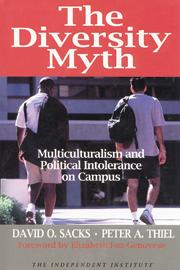For the past quarter of a century, Stanford has been discriminating in favor of racial minorities in admissions, hiring, tenure, contracting, and financial aid. But only recently has the University been forced to rethink these policies in the face of an emerging public debate over affirmative action.
We are beginning to see why. Originally conceived as a means to redress discrimination, racial preferences have instead promoted it. And rather than fostering harmony and integration, preferences have divided the campus. In no other area of public life is there a greater disparity between the rhetoric of preferences and the reality.
Take, for instance, the claim that racial preferences help the “disadvantaged.” In reality, as the Hoover Institution’s Thomas Sowell has observed, preferences primarily benefit minority applicants from middle- and upper-class backgrounds. At the same time, because admissions are a zero-sum game, preferences hurt poor whites and even many Asians (who meet admissions standards in disproportionate numbers). If preferences were truly meant to remedy disadvantage, they would be given on the basis of disadvantage, not on the basis of race.
Another myth is that preferences simply give minority applicants a small “plus.” In reality, the average SAT disparity between Stanford’s African American and white admittees reached 171 points in 1992, according to data complied by the Consortium on Financing Education and cited in Richard Herrnstein and Charles Murray’s book, The Bell Curve.
The fundamental unfairness and arbitrariness of preferences—why should the underqualified son of a black doctor displace the qualified daughter of a Vietnamese boat refugee?—has led supporters to shift rationales in recent years. Instead of a remedy for disadvantage, many supporters now claim that preferences promote “diversity.” The same push for “diversity” also has led Stanford to create racially segregated dormitories, racially segregated freshman orientation programs, racially segregated graduation ceremonies and curricular requirements in race theory and gender studies.
But if “diversity” were really the goal, then preferences would be given on the basis of unusual characteristics, not on the basis of race. The underlying assumption—that only minorities can add certain ideas or perspectives—is offensive not merely because it is untrue but also because it implies that all minorities think a certain way.
What’s gone wrong? The basic problem is that a racist past cannot be undone through more racism. Race-conscious programs betray Martin Luther King’s dream of a color-blind community, and the heightened racial sensitivity they cause is a source of acrimony and tension instead of healing.
When University officials boast of “looking for racism everywhere,” as multicultural educator Greg Ricks did in a 1990 Stanford Daily interview, then perhaps the most sensible (and certainly the most predictable) response will be for white students to avoid dealing with such quarrelsome people. In this way, the stress on “diversity” has made interracial interaction strained and superficial; multiculturalism has caused political correctness.
None of this is to deny that there are some people in America who are racist and that there are some features of American life that are legacies of a much more racist past. But racism is not everywhere, and there is very little at a place like Stanford. Certainly, no one has accused Stanford’s admissions officers of being racist, so perhaps the real problem with affirmative action is that we are pretending to solve a problem that no longer exists. Moreover, there is a growing sense that if affirmative action has not succeeded in ending discrimination after 25 years of determined implementation, then perhaps it is time to try something else.
Although Stanford’s admissions office cannot undo the wrongs of history, its mission is still very important—namely, admitting the best class of students it can find. The sole criterion in finding the members of this class and in defining “merit” should be individual achievement—not just grades and test scores, of course, but a broad range of accomplishments, in athletics, music, student government, drama, school clubs and other extracurricular efforts. But race and ethnicity (or gender or sexual preference) do not have a place on this list; these are traits, not achievements.
Perhaps the most tragic side effect of affirmative action is that very significant achievements of minority students can become, compromised. It is often not possible to tell whether a given student genuinely deserved admission to Stanford, or whether he is there by virtue of fitting into some sort of diversity matrix. When people do start to suspect the worst—that preferences have skewed the entire class—they are accused of the very racism that justifies these preferences. It is a strange cure that generates its own disease.
A Stanford without affirmative action will be a Stanford in which the question of who belongs here will no longer need to be answered. It will no longer need to be answered because it will no longer need to be asked, not even sotto voce.








